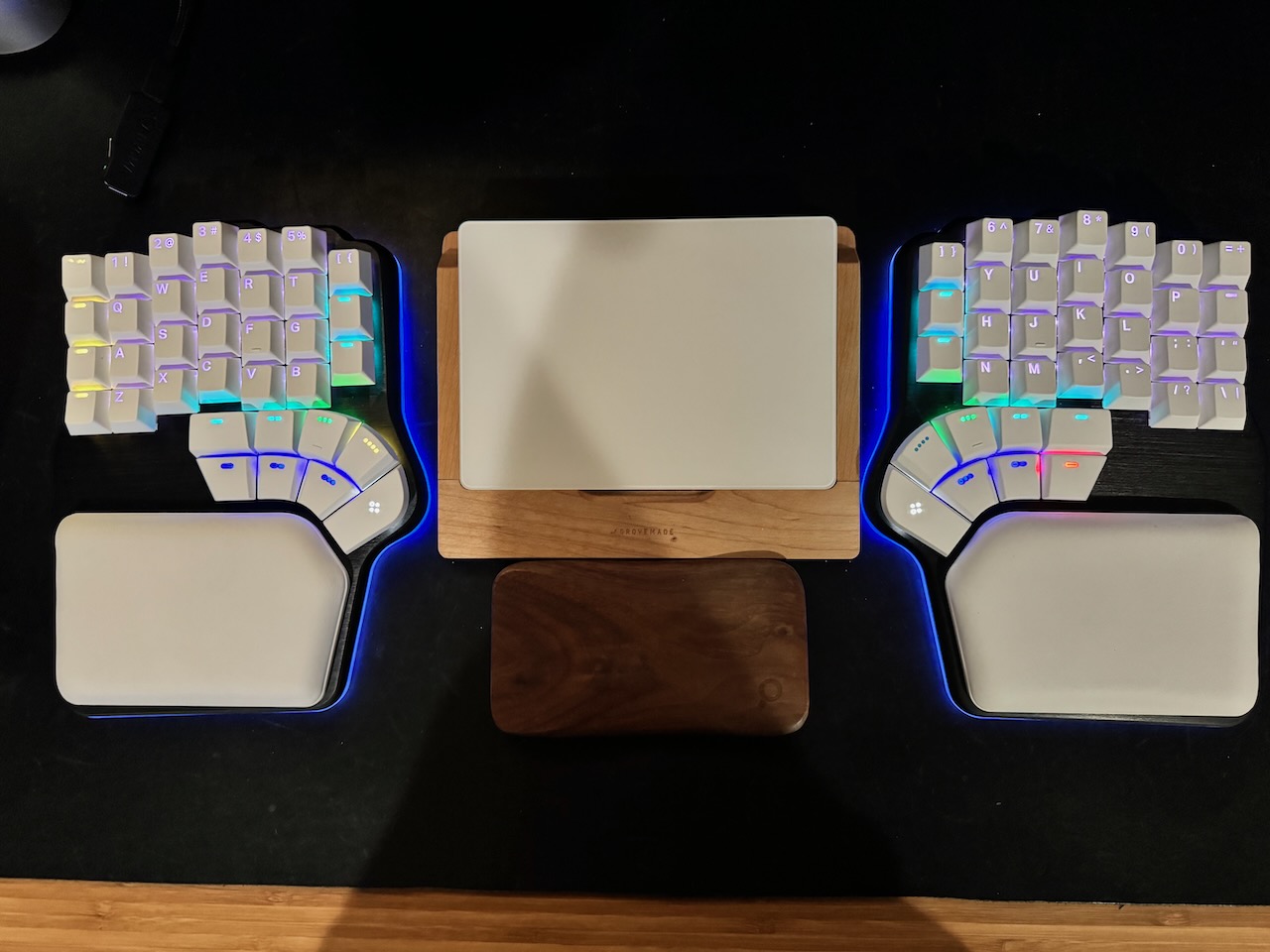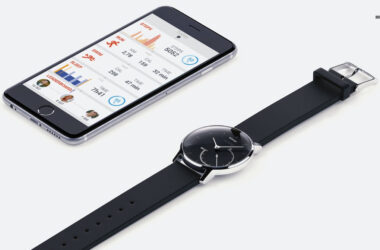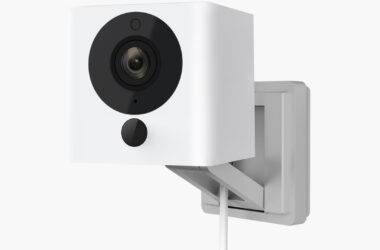A year ago, I ordered and reviewed the Kinesis Advantage360: a modern update to the Advantage line of ergonomic keyboards1. As I noted with that review though, custom keyboards have come a long way in the past few years, and customers today can cross-shop from many more options2. The Dygma Defy caught my eye as an alternative with a ton of potential, so I preordered one to check out another manufacturer’s take on this hardware niche.
Out of sheer coincidence, similar to the Advantage360, Dygma Labs took a year to go from my preorder to full production, beset by a handful of delays ranging from COVID-related complexities to redesigning auxiliary parts to difficulties with mass manufacturing. As of this writing, they’re still working through the shipping logistics but have delivered most of the preorders, so folks are starting to get their hands on the end product but I haven’t seen that many write-ups.
So here’s a first impressions review!
Dygma
According to their website, Dygma Labs was founded in 2017 by a former e-sports coach who wanted to make better, more ergonomic gaming hardware. It’s a unique crossover; most gaming manufacturers end up emphasizing features like RGB lighting and extra knobs and macro keys, but Dygma started with ergonomics and tried to evolve the niche with more mass-market appeal, albeit at a premium.
The company is based out of Spain, with manufacturing and assembly primarily in China. They have only a handful of products, but they stand behind their work by staying active on their Discord and subreddit. They also produce regular videos on their YouTube channel, with some legitimately informative and useful tutorials for those getting into this hobby.
The Defy
The Defy is a split, wireless, columnar mechanical keyboard with a boatload of features. There’s quite a lot to go through, so I’ve categorized the features into 3 primary audiences:
- Mech keyboard enthusiasts, valuing things like keycap quality, case materials and build quality, sound signatures, programmability;
- Ergonomic geeks, looking for features like split halves, wireless, mounting support3, tenting solutions, thumb clusters;
- Gamers, caring about their LEDs, programming macros, and keypress latency, on top of many of the same attributes as the mechanical keyboard crowd.
The Defy addresses each of these target user groups surprisingly well4. Let’s tackle these one at a time.
A Mechanical Keyboard
The Defy’s industrial design is on par with modern mechanical keyboards, while its build quality is a bit better than most ergonomic ones. It’s built with a brushed aluminum chassis, adorned with a magnetically attached set of palm pads. The PCB allows for hotswap mechanical switches5, connects wired or wirelessly via either Bluetooth or RF, and presents a unique 72-key layout—approximately a 60% compact keyboard plus a pair of 8-key thumb clusters per side. It adds quality Cherry profile ABS keycaps; the character etching is translucent and combines with the strong LEDs underneath each key to shine with its dedicated color.
On the software side, the Defy is configured with Bazecor, an electron app built on top of another keyboard configurator open-sourced by another keyboard company called Chrysalis It’s a bit too Logitech gaming for my liking, but adds some features—including esoteric ones like one-shot keys and tap-hold combinations—more typically found in enthusiast firmware like QMK or ZMK with a friendlier interface. As the keyboard is still in the middle of its launch, the firmware updates frequently, though its lack of maturity is showing, with scattered bugs and inconsistent battery drain.
An Ergonomic Keyboard
The most striking thing about the Defy, and what makes the biggest first impression, is the massive thumb cluster; I’ve waxed poetically about the ergonomic advantages of making your thumbs do more work. They are the most dexterous digits on your hands, in contrast with your pinkies which are the weakest. Ergonomic layouts move some of the common utility keys—Enter ⌅, Backspace ⌫, Shift ⇧, Control ⌃, Cmd ⌘—from the latter to the former.
Some keyboards like the Dactyl and Advantage lay out clusters of keys accessible by thumbs, but they’re positioned far enough to require stretching your hands away from the home row to reach. Others like the Model 100 follow the natural curve of your thumbs’ reach6, which is also how the Defy angles its keys. The difference is that each thumb gets 8 keys laid out in 2 rows—the lower one uses low-profile Choc switches—giving them access to as many keys as your index fingers.
The rest of the keyboard is laid out with staggered columns, where each column has its position shifted to account for finger length. By comparison, the Advantage features an ortholinear grid, which works well with the concave key well but is less comfortable with a flat base7. The muscle memory adjustment comes from transitioning from the traditional staggered layout.
Finally, the built-in tenting system is pretty clever. Using 3 aluminum legs and a whole lot of notches, the Defy allows for 5° to 60° of tenting upwards, along with 5° to 10° of reverse tilt. The range is impressive and much wider than other solutions, and it’s simple to tweak and experiment with different angles8. The legs are solid, albeit quite thin, but they keep the base from wobbling when typing; time will tell whether they hold up with years of use.
A Gaming Keyboard
The Defy has a disgusting number of LEDs. RGB lights are common for gaming keyboards, and the pricier ones also include underglow LEDs, but it’s another level altogether to shove 53 RGBW LEDs on the underside with independent control. They’re also very bright: even at 20–25%, they shine through the keycaps nicely. There seem to be a couple of lighting animations built into the firmware, but right now no way to program them. Getting too fancy with the lights, though, will drain the batteries within a day or two.
The other gaming-centric feature is the support for low-latency RF connectivity. It uses an adapter called the Neuron as a complicated multifunctional connector:
- The Neuron connects to the computer, and then splits out 2 USB-C connections to each half, for a wholly wired connection9;
- The Neuron plugs into one side and acts as a Bluetooth adapter that supports up to 5 separate devices;
- The Neuron connects to the computer, and then wirelessly communicates with the Defy via 2.4GHz RF.
The wired setup is self-explanatory, and Bluetooth wireless is pretty standard as well. RF is something more commonly found in gaming hardware; it features lower latencies on average compared to Bluetooth connections. It’s not the only tri-mode gaming keyboard on the market, but this Neuron solution is fairly elegant.
Other gaming-centric features, like macro recording and n-key rollover (NKRO), are supported.
Some Other Stuff
The Dygma Labs team did a good job with the unboxing experience. The shipping box and bubble wrap packaging are custom-designed 10; the carrying case is lined with soft felt and opens to reveal the full keyboard along with a molded slot for the Neuron; the full kit includes 4 USB-C cables, a USB-C → USB-A adapter, extra dashed keycaps, and an Enhancement Kit with an assortment of tools and extra parts.
I also appreciate the attention to detail in the hardware design. The USB cables are braided and shielded, and come in various lengths to accommodate different setups. The kit added a box of thin washers for switches to solve a potential keycap interference problem. And since the Cherry profile shapes each row differently, Dygma’s keycaps have the row labels lightly molded on the back for easy identification.
Lastly, there’s the cost of all this goodness. The Defy starts at $370, but with custom panel colors and all the bells & whistles it can be configured up to $680. It reminds me a bit of that old Steve Jobs iPhone reveal—but instead of an iPod, phone, and internet communications device in one product, this is a mechanical, ergonomic, and gaming keyboard in one device. The price points for each of these categories have standardized: Keychron mechanical keyboards are priced in the $100–$200 range; popular ergonomic options like the Advantage360, ZSA Moonlander/Voyager and Glove80 are in the $300+ range; flagship gaming keyboards from Asus and Razer are around $200. From a price standpoint, this keyboard is probably best thought of as an ergonomic option, with a couple of details not offered by other ergonomic keyboard manufacturers.
Final Thoughts
The Dygma Defy keyboard launched during a turbulent time for the mechanical keyboard industry. The hobby received a boost during COVID11, but that heightened activity has pulled back in proportion to the virus’s retreat, to the point where some smaller vendors have struggled to stay in business. The overall quality in hardware, though, has continued to improve and that bar is permanently raised, compared to even just 4–5 years ago. To that end, Dygma Labs deserves credit for meeting this newly risen standard, innovating in a couple of new areas along the way. They just announced a v2 of their Raise keyboard, with many of the hardware features developed for the Defy.
As of this writing, I have been using this keyboard for about a week. Unequivocally, It is a high-end, premium device, though with a price to match12. Mechanical enthusiasts—both of the keyboard and watch variety—speak of their “endgame” objects: the ideal, dream final build or purchase that checks off every box of personal preferences and squelches that instinct to look for something better. The Defy certainly does a lot right; it’s a worthy hat to throw into the endgame ring.
I’ve been a fan for a decade, and I still have 2–3 of the older versions of this keyboard in my closet.↩
In particular, the ergonomics crowd likes to experiment with unusual form factors via 3D-printed cases.↩
Some people mount their keyboards onto their chair’s armrests.↩
This keyboard caught my attention because I’ve been, or am currently, a member of each audience type.↩
One downside of concave well keyboards like the Advantage series or the Glove80 is that the curvature makes it difficult to stabilize switch sockets so they’re soldered onto the board.↩
I’m reminded of smartphone UX studies that highlight where to place UI elements on the screen for easy thumb reachability.↩
I have the Preonic and ID75, and they look neat but don’t offer any real ergonomic benefits.↩
Built-in tenting systems aren’t common, and are usually hard to adjust.↩
On MacOS, it detects the Neuron as the input device, so I assume it’s then managing the signals between the halves.↩
I think I read on their Discord that they took the extra effort to produce black wrappers.↩
That was when I started getting into it, too.↩
Maybe it’d be more appropriate to compare this keyboard to something like the Angry Miao Am Hatsu?↩




